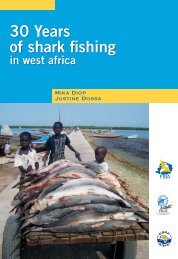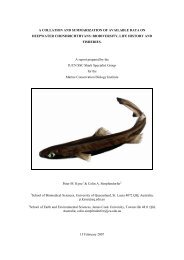Abercrombie et al_Fi..
Abercrombie et al_Fi..
Abercrombie et al_Fi..
You also want an ePaper? Increase the reach of your titles
YUMPU automatically turns print PDFs into web optimized ePapers that Google loves.
Silky shark (Carcharhinus f<strong>al</strong>ciformis)<br />
Distribution: Widely distributed in warm temperate to tropic<strong>al</strong> regions.<br />
Habitat: Primarily offshore. Mostly taken in pelagic fisheries.<br />
Pector<strong>al</strong> fin description<br />
The dors<strong>al</strong> surface is brown to<br />
greyish-brown in color and has<br />
a smooth texture with sm<strong>al</strong>l<br />
denticles. The fin is narrowly<br />
rounded at the apex with a visible<br />
dusky coloration at the ventr<strong>al</strong><br />
surface, has a nearly straight<br />
trailing edge (not visibly f<strong>al</strong>cate)<br />
and narrow free rear tip.<br />
Similar species: Dusky, bull, night and Caribbean reef shark pector<strong>al</strong> fins (not included in this guide<br />
due to lack of sufficient samples for comparison) are a very similar in shape and coloration,<br />
but the dusky markings on the ventr<strong>al</strong> surface are less concentrated at the apex and the trailing<br />
edge is more f<strong>al</strong>cate in these species than seen in the silky. Bull pector<strong>al</strong> fins <strong>al</strong>so have larger<br />
denticles (s<strong>al</strong>t grain-like).<br />
42
















